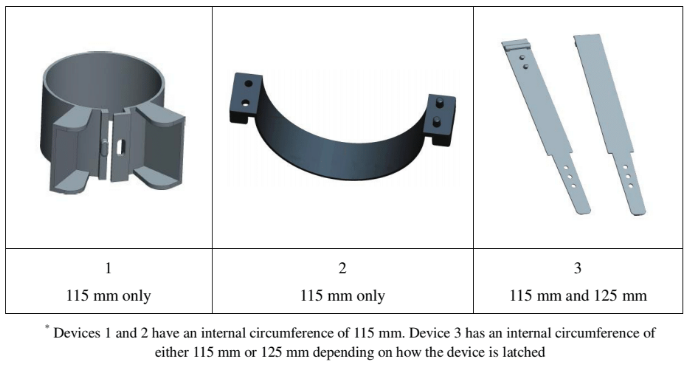Key findings from the Click-MUAC Project
Summary of presentation1
By Angeline Grant, Zvia Shwirtz, James Njiru, André Briend and Mark Myatt
Angeline Grant is Senior Nutrition and Health Advisor at Action Against Hunger US. Angeline has previously worked in the areas of nutrition assessment, nutrition programme implementation, nutrition cluster coordination and nutrition-sensitive programming in West Africa, East Africa, the Middle East and South East Asia.
Zvia Shwirtz currently works as the Research Uptake Technical Advisor for Action Against Hunger US, working closely with colleagues to ensure that evidence and results produced from research projects are effectively communicated to key stakeholders in policy and practice and used to inform decision-making.
James Njiru is Research and Learning Coordinator at Action Against Hunger Kenya Mission. James has over 12 years’ experience in nutrition programming in policy formulation, project/programme design and management, MIYCN, health system strengthening and advocacy.
André Briend, a Medical Doctor with a PhD in nutrition from Paris University, with over 30 years of experience in research in pediatric nutrition in developing countries. Currently he is Adjunct Professor at the University of Tampere, Department for International Health, Finland, and Affiliated Professor, Department of Nutrition, Exercise and Sports, Faculty of Science, University of Copenhagen, Denmark.
Mark Myatt is a Consultant Epidemiologist and Senior Research Fellow at the Division of Opthalmology, Institute of Opthalmology, University College London. His areas of expertise include infectious disease, nutrition and survey design.
Location: Kenya
What we know: Mid-upper arm circumference (MUAC) is increasingly used for community screening to detect acute malnutrition; screening by mothers is being explored.
What this article adds: A study in Kenya by Action Against Hunger described the performance of three Click-MUAC devices measured against a gold standard (study team measurements) for classification of nutritional status. Mothers/caregivers and clinic staff demonstrated good sensitivity and excellent specificity using the Click-MUAC tapes and the uniMUAC tape. The uniMUAC tape performed best for both mothers/caregivers and clinic staff (sensitivity and specificity); one-to-one instruction and recent improvements in design may have helped. Action Against Hunger is now piloting a simplified version of the uniMUAC tape for mothers/caregivers in Isiolo County.
Background
Regular screening for acute malnutrition at community level is key to improving the coverage of acute malnutrition treatment. Frequent screening can also enhance early detection, which can potentially lead to shorter treatment times, leading in turn to reduced programme costs (Sadler et al, 2017; Puett et al, 2013). The measurement of mid-upper arm circumference (MUAC) is the most common form of anthropometric screening used at community level to detect acute malnutrition. Until recently, this has primarily been carried out by community health workers (CHWs) or community-based volunteers. However, emerging evidence (Alé et al, 2016; Blackwell et al, 2015) points to the important role that mothers and other caregivers can also play in this process by screening their own children for acute malnutrition.
Building on this recent evidence, Action Against Hunger (AAH) set out to develop a set of three prototype Click-MUAC devices to support the mother/family MUAC approach and to test them in an operational setting. The idea was to simplify and standardise the measurement of MUAC to increase the sensitivity and specificity2 of mother and caregiver classifications of acute malnutrition.
Study objectives
The primary aim of the study was to describe and compare the performance, in terms of agreement, of the three Click-MUAC devices against a gold standard3 for the classification of nutritional status. A secondary aim was to determine the difference in agreement among mothers/caregivers using the Click-MUAC devices and mothers/caregivers using a MUAC insertion tape.
Methods
The study team developed three Click-MUAC devices with the help of plastics specialists, using a plastic printing injection process (see Figure 1). The study also used a universal design, colour-banded MUAC insertion tape (“uniMUAC”), designed and produced by a consortium of non-governmental organisations (NGOs) and academics led by Médecins Sans Frontières (MSF) (see Figure 2). The study was designed as a prospective, non-randomised, non-blinded, clinical diagnostic trial to describe and compare the performance of the devices. It was implemented in Isiolo County, Kenya, from September 2016 to January 2017. Mothers/caregivers and clinic staff used the Click-MUAC devices and the uniMUAC insertion tape to classify the nutritional status of the child and these classifications were compared to a gold standard measurement taken by the study team.
Figure 1: The three Click-MUAC prototypes used in the study
Figure 2: Features of the universal design MUAC insertion tape used in the study

Key findings
An article describing the results of the Click-MUAC study in full is currently pending publication (Grant et al.). In summary, the study was successful in describing and comparing the performance of the devices. A total of 1,040 children were assessed over the course of the study and the minimum sample sizes (n=115) were reached for all categories (MUAC ≥125mm; 115mm ≤ MUAC < 125mm; and MUAC < 115mm).
Mothers/caregivers using the Click-MUAC devices demonstrated good sensitivity and excellent specificity in the classification of severe acute malnutrition (SAM) using all four devices and global acute malnutrition (GAM), comprising both SAM and MAM (only possible using Click-MUAC device three and the uniMUAC tape). This was also the case for clinic staff. The results, notably for sensitivity, are higher here than in previously reported mother-MUAC studies. The Click-MUAC device that enabled the classification of both SAM and MAM (prototype three) was the best performing Click-MUAC device.
However, the most surprising aspect of the study was the fact that, while the Click-MUAC devices performed well, the device that performed best was the uniMUAC tape and the difference in performance was statistically significant. Both mothers/caregivers and clinic staff showed excellent results for sensitivity and specificity in the classification of acute malnutrition (GAM and SAM) using the uniMUAC tape.
Conclusion and next steps
The results of this study indicate that, although the Click-MUAC devices performed well, the uniMUAC insertion tape performed best for mothers and caregivers in classifying the nutritional status of their own children. It is thought that certain new design features of the uniMUAC tape (see Figure 2) may have helped to improve its sensitivity for the classification of acute malnutrition. It is also thought that some design issues (concerns with skin-pinching for Click-MUAC devices one and two and unwieldiness for Click-MUAC device three) may have contributed to reducing the sensitivity of the Click-MUAC devices compared to the uniMUAC tape.
The results for sensitivity for the classification of acute malnutrition by mothers/caregivers are higher than in previously reported studies for all devices (both Click-MUAC and uniMUAC). This may be due to the method of demonstration of the devices, which was a one-on-one demonstration to the mother/caregiver by the study team, whereas previous studies used mass demonstration techniques. Previous studies also used conventional MUAC tapes, whereas this study used a uniMUAC tape with an improved design; this may also have contributed to the increase in the sensitivity of the classifications.
Overall, the findings from the Click-MUAC project help to bolster the evidence that mothers and caregivers can indeed understand MUAC measurement and perform measurements with good sensitivity and specificity. All devices performed well; however the uniMUAC tape performed best and – crucially – can be manufactured more cheaply. AAH strongly supports the mother/family MUAC approach and is now involved in piloting a simplified version of the uniMUAC tape for mothers/caregivers (see Figure 3) in an operational pilot in Isiolo County. Data collection on this stage of the Click-MUAC project is ongoing with the intention of examining the uptake of the approach by mothers/caregivers, its potential impact on admissions and the level of buy-in from the local health system and authorities.
Figure 3: Simplified version of the uniMUAC tape

For more information, contact Angeline Grant.
Published findings can be found at this link.
Endnotes
1Presentation at the ACF Research for Nutrition Conference, Pavillon de L’Eau, 13th November, 2017.
2n this study sensitivity was defined as the ability of a device to correctly detect patients with the condition (SAM or MAM); specificity was defined as the ability of a device to correctly detect patients without the condition (SAM or MAM).
3The gold standard for this study was the mean of three MUAC measurements taken by the study team with a universal MUAC tape (“uniMUAC”).
References
Alé F, Phelan K, Issa H, Defourny I, Le Duc G, Harczi G, Issaley K, Sayadi S, Ousmane N, Yahaya I, Myatt M, Briend A, Allafort-Duverger T, Shepherd S, Blackwell N. Mothers screening for malnutrition by mid-upper arm circumference is non-inferior to community health workers: results from a large-scale pragmatic trial in rural Niger. Arch Public Health. 2016; 74(1):38
Blackwell N, Myatt M, Allafort-Duverger T, Balogoun A, Ibrahim A, Briend A. Mothers Understand it And Can do it (MUAC): A comparison of mothers and community health workers determining mid-upper arm circumference in 103 children aged from 6 months to 5 years. Arch of Public Health 2015; 73 (1):26
Grant A, Njiru J, Okoth E, Awino I, Briend A, Murage S, Abdirahman S, Myatt M. Comparing performance of mothers using simplified mid-upper arm circumference (MUAC) classification devices with an improved MUAC insertion tape in Isiolo County, Kenya; Pending publication.
Puett C, Coates J, Alderman H, Sadler K. Quality of care for severe acute malnutrition delivered by community health workers in southern Bangladesh. Matern Child Nutr. 2013; 9:130-42.
Sadler K, Puett C, Mothabbir G, Myatt M, 2011. Community Case Management of Severe Acute Malnutrition in Southern Bangladesh. Tufts University, 1-48. Accessed from: http://fic.tufts.edu/publication-item/community-case-management-of-severe-acute-malnutrition-in-southern-bangladesh/ 4 May 2017



